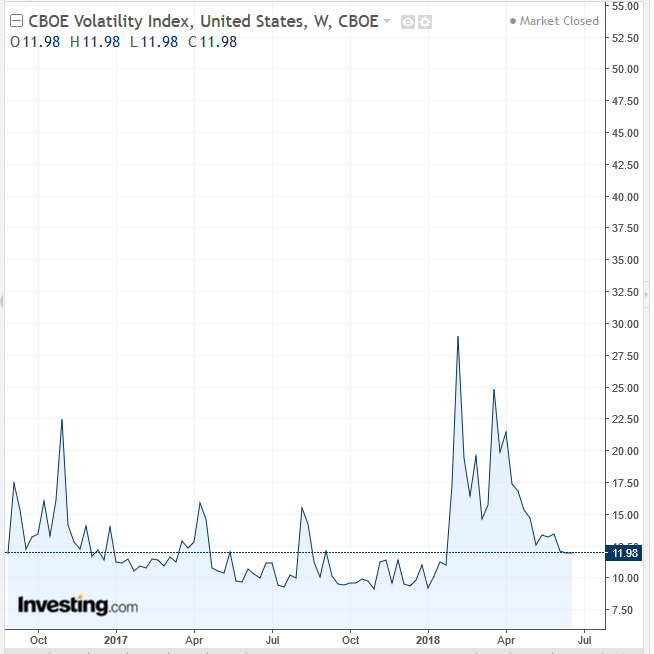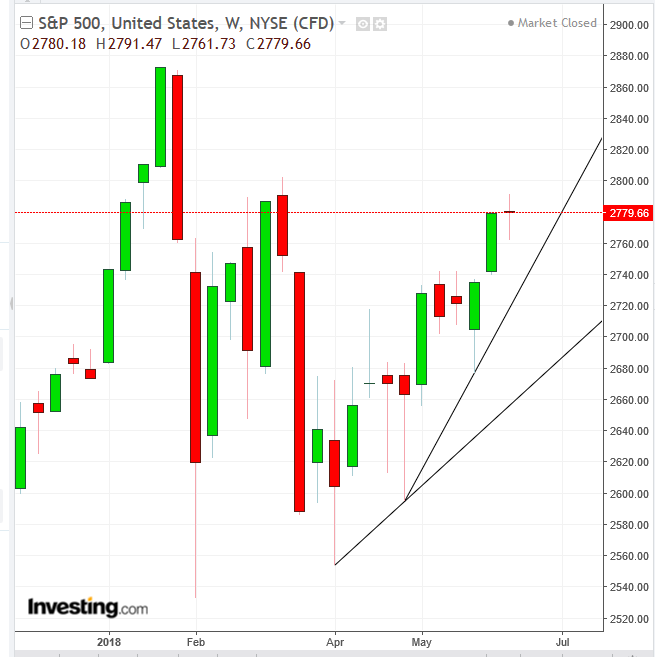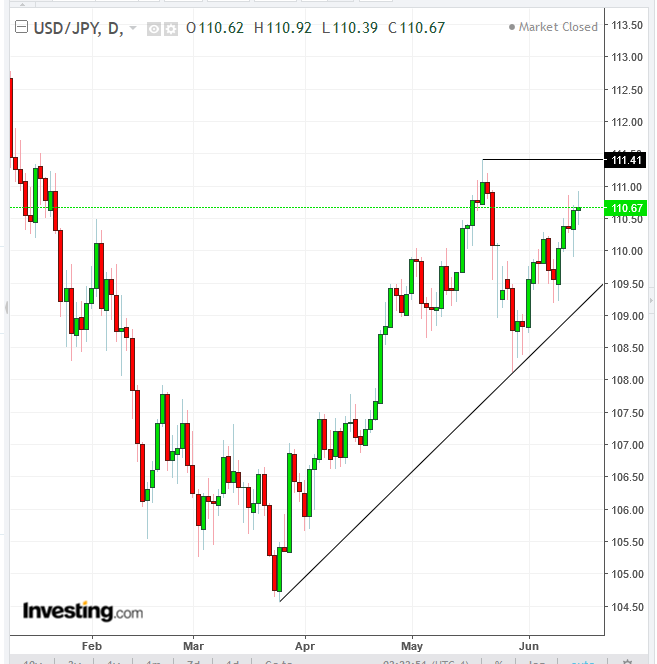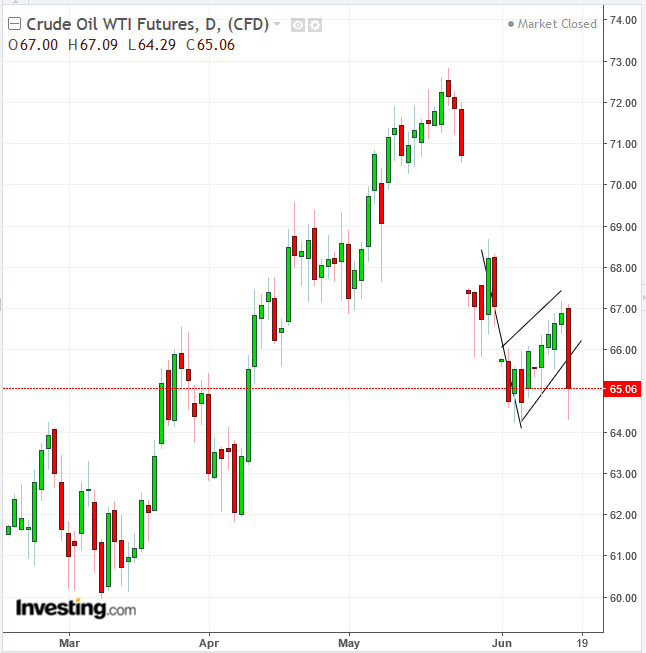- US equity markets remain relatively unchanged after event-filled week
- US dollar wipes out two weeks worth of losses
- Fed skews hawkish, signaling fourth rate hike in 2018
- ECB to halt bond buying at year-end
- US-China trade war heats up, weighing on Dow
The broad US stock market remained relatively unchanged after what could arguably be characterized as the most event-filled week in recent memory. Perhaps even more significant, the dollar wiped out two weeks of losses, reaching its highest level since October 2017. Though equities may have recently corrected, market signals indicate that stocks are still pointing higher.

The fact that a week plagued with so much uncertainty—three central bank monetary policy decisions, fallout from last weekend's disastrous G7 outcome, an historic but ultimately meaningless US-North Korea meeting on Pyongyang's denuclearization and the latest volley in the increasingly smoldering US-China trade war—couldn’t bring equity traders to their knees speaks of investor resolve buoying US markets. As well, volatility is near the lowest since January, though still higher than most of last year.
Market Internals Mixed
Nonetheless, the Dow Jones Industrial Average underperformed. It declined 0.34 percent on Friday and 0.95 percent for the week. That's not so surprising since the 30 mega-cap, multinational companies listed on the index are most reliant on overseas markets and thus most sensitive to tariffs.
The US-China trade war picked up steam on Friday when President Donald Trump’s administration released a list of $50 billion worth of Chinese goods targeted for tariffs. In response, China said it would levy tariffs on some American imports starting next month. But this may only be the beginning. Reports suggest the US is preparing a second list of targeted goods worth as much as $100 billion; China has already responded that it doesn’t want a trade war but would have to counter.

US stocks might have been relatively unfazed, but China's Shanghai Composite dropped 0.8 percent, closing Friday at its lowest level since September 2016. Technically, however, it remained above the 3,000 psychological price, a support level since January 2017.
The S&P 500 Index retreated on Friday as well, albeit an insignificant 0.1 percent, after the US announced the tariff increases and China vowed retaliation.

On a weekly basis the benchmark index fell less than 0.05 percent. Technically, it posted its highest close since the double-digit correction in February, 2786.85 on Tuesday, reaching a higher peak than the 2786.57 of March 9, confirming the uptrend since the April bottom. On the other hand, the High Wave candle at the end of the week expresses a lack of leadership, a sign that the uptrend might lose steam and perhaps retest the uptrend line.
The NASDAQ Composite lost 0.2 percent Friday but gained 1.3 percent on the week, to outperform. The Russell 2000 closed a mere 0.05 percent lower Friday but was up 0.65 percent for the week. The small-cap stocks listed on the Russell generally do not rely on exports for growth, insulating them from any trade hostilities.
So, what can we expect for the individual major US indices? The fact that neither geopolitics nor central bank decisions put a dent in investor mood demonstrates tremendous resilience. The only single day of significant declines last week occurred after a series of Chinese releases on Wednesday—including industrial production and retail sales—showed signs of weakness in the world's second largest economy. What's the takeaway? There appear to be only three things investors in a post-Brexit-vote world respond to: economics, market fundamentals and market technicals.
Still, there are some fundamentals that could be more damaging to markets than others. The most sensitive sectors to the trade war have been Technology hardware and Industrials. As Jay Pelosky, chief investment officer at TPW Investment Management LLC, said on Bloomberg TV:
"If there’s anything that goes wrong with technology—and here we are talking about in these tariffs attacking U.S., China technology—if the tech sector gets hit in any way, the market has a major problem.”
Dollar Uptrend Ahead But Safe Haven Yen Could Surprise
Last week's three major central bank meetings had varying affects on FX. Currency trade took surprising turns after both the US and EU monetary policy decisions.
On Wednesday, as expected the Fed increased rates to the target range of 1.75 percent-2 percent. However, the Fed then skewed more hawkish by forecasting an outlook for a fourth, surprise hike for 2018, as Chair Jay Powell presented a positive outlook for the US the economy, pointing to record-low unemployment alongside low inflation.
The dollar jumped almost half a percent within the hour, but closed the hour at a much more modest 0.15 percent gain, only to lose that too and finish the day down 0.1 percent. It doesn't make sense for traders to have sold off the currency after the Fed did everything it was expected to do, and more.
The only possible explanation: a negative outlook for the greenback in a ramped up trade war after the unsatisfactory G7 summit. Still, why would traders then sell the dollar on Wednesday, for something that happened before the trading week actually began? Perhaps they were aiming to get out ahead of Thursday’s ECB meeting, which was expected to feature the announcement of the end of QE in the single market, and thus might have overshadowed the dollar’s relatively muted outlook.
On Thursday the ECB did in fact make the historic announcement that it will reduce the volume of its asset purchase program from €30 billion a month to €15 billion a month starting in October, dropping that to zero at the end of the year.

The euro reacted similarly to the dollar on the previous day. It rose 0.5 percent immediately after the announcement, then preceded to plunge a whopping 1.9 percent the following morning, the single currency's worst performance in two years, before turning slightly higher.
Have FX traders lost their minds? Mario Draghi's very dovish guidance on the timing of the first rate hike pushed European bond yields and the euro lower as the bank said it will keep its refinancing rate at -0.4% at least through the summer of 2019. With Draghi's eight-year term as ECB president set to expire in October 2019, it's conceivable he could end his tenure without ever having presided over an interest rate hike. Markets welcomed the pairing of the end of quantitative easing with dovish forward guidance as the combination will likely prevent significant tightening in financial conditions. Technically, despite the euro's worst sell off in two years, it found demand above the 1.1500 psychological level, a line of support since October 2017.
As widely expected, on Friday, the Bank of Japan kept its short-term interest rate target at minus 0.1 percent and pledged to guide 10-year government bond yields to around zero percent. "Consumer price growth is in a range of 0.5 to 1 percent," the BOJ said in a statement accompanying the decision. That was a slightly bleaker view than in the previous meeting in April, when the central bank said inflation was moving around 1 percent.
The JPY dropped 1 percent, of which only 0.04 percent occurred after the decision.Then USD/JPY pair swung 0.5% between losses and gains throughout Friday trade.

The yen lost 1.00 for the week, but 0.8 percent of that was on the Monday and Tuesday, during the lead-up to the Trump-Kim “comprehensive denuclearization” document signing. Investors would demonstrate faith in economic growth and no need for safe havens, when they allow the USDJPY to overcome its preceding, May 21 peak of 111.41. The pair would need to do so to maintain its uptrend since late March.
Prior to last week, the debate over the outlook for the dollar has been predicated upon whether major central banks would keep up with the Fed's tightening. Now that the two most important central banks have tipped their hands, it fundamentally paves the uptrend for the dollar.
The only hitch may come from some things we've reported on recently. Central banks have begun changing their weighting of foreign currency in favor of the euro at the expense of the dollar, in reaction to Trump’s escalating trade war. As well, China launched a yuan-denominated oil futures market which may divert demand away from the greenback to the Chinese yuan. Of course, the yen could always surprise as a haven currency.
Week Ahead
All times listed are EDT
Sunday
19:50: Japan – Trade Balance (May): surplus forecast to narrow to ¥406 billion.
Tuesday
8:30: US – Housing Starts and Building Permits (May): starts forecast to rise 1.8% from a -3.7% fall, and permits to fall 0.6% from -0.9
10:50: Japan – BoJ Minutes: should shed more light on the Bank of Japan's current thinking on monetary policy.
Wednesday
9:30: Eurozone – ECB Central Bank Forum, Portugal: the ECB will host central bankers from around the globe, with speeches from RBA Governor Lowe, ECB President Draghi, BoJ Governor Kuroda and Fed Chair Powell.
10:00: US – Existing Home Sales (May): forecast to rise 1.5% MoM from a 2.5% drop.
10:30: US – EIA Crude Inventories (w/e 15 June): expected to rise by 690,000 barrels from a 4.14 million barrel drop a week earlier.

The Energy sector led Friday's declines (-2.15 percent), as well as those for the week (-3.55 percent), after oil prices plunged at the prospect of OPEC and Russia easing their production cuts at their monthly meeting next week in Vienna.
21:30: Australia – RBA Bulletin: the Royal Bank of Australia's update on the economic and financial health of Australia.
Thursday
7:00: UK – BoE Interest Rate Decision: no change in rates expected, but watch for any changes in the voting pattern from the last vote which was 7/9 in favor of leaving rates unchanged.
8:30: US – Philadelphia Fed Manufacturing Index (June), Initial Jobless Claims (w/e 16 June): Philly Fed index expected to fall to 28 from 34.4k; initial jobless claims expected to rise to 223K from 218K.
16:30: US – Fed publishes bank stress test results: the US central bank will issue the results of these tests. Bank shares and other financial stocks will be in focus.
7:30: Japan – CPI (May): expected to rise 0.8% from 0.6% YoY, and 0.2% from -0.4% MoM.
19:30: Japan – Manufacturing PMI (June, flash): forecast to fall to 52.4 from 52.8.
Friday
All Day – OPEC meetings, Vienna: the oil cartel will discuss production levels at its regular meeting.
4:00 – 5:00: French, German, Eurozone Manufacturing and Services PMIs (June, flash): these initial readings provide a gauge of activity in key parts of these economies.
8:30: Canada – CPI (May): price growth expected to be 2.2% YoY, in line with last month, and 0.2% MoM, from 0.3% in April.
9:45: US – Manufacturing and Services PMI (June, flash): manufacturing PMI to fall to 54 from 56.6, and services to rise to 56.5 from 56.4.
